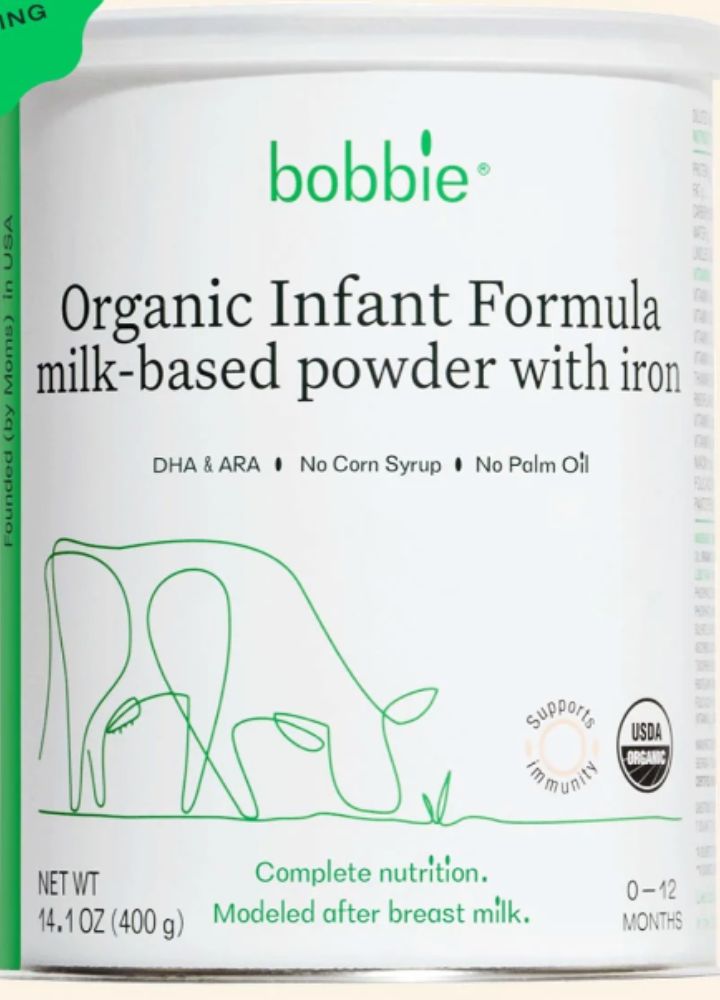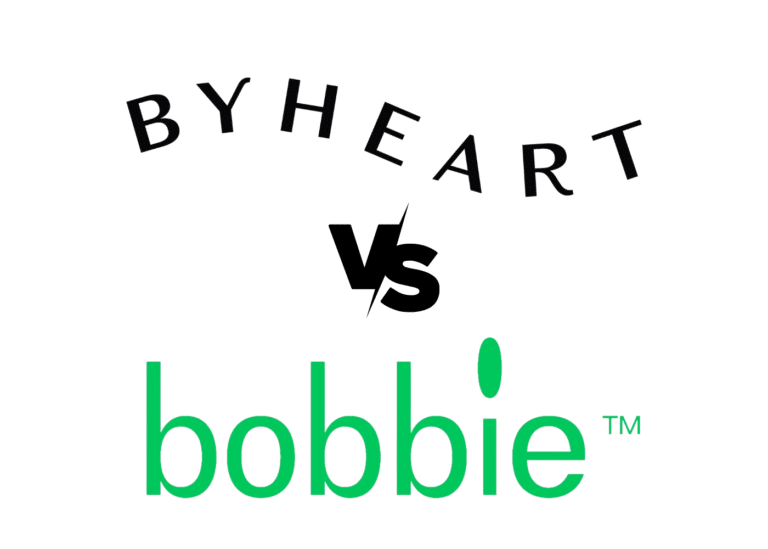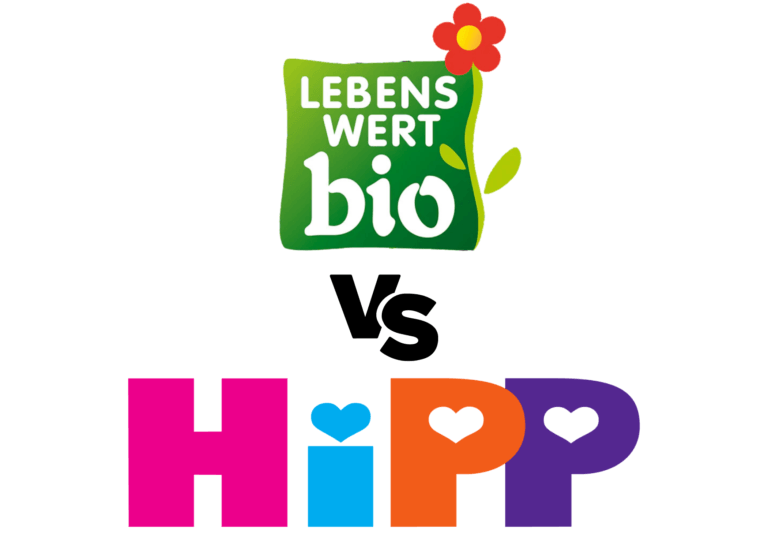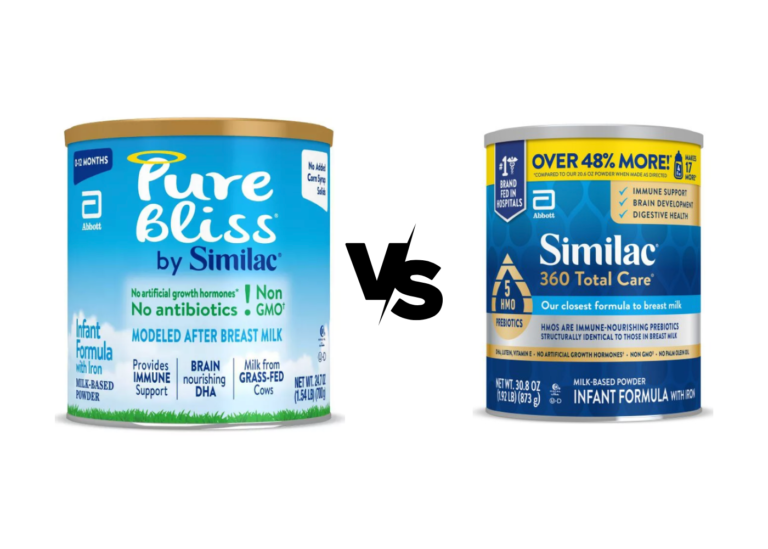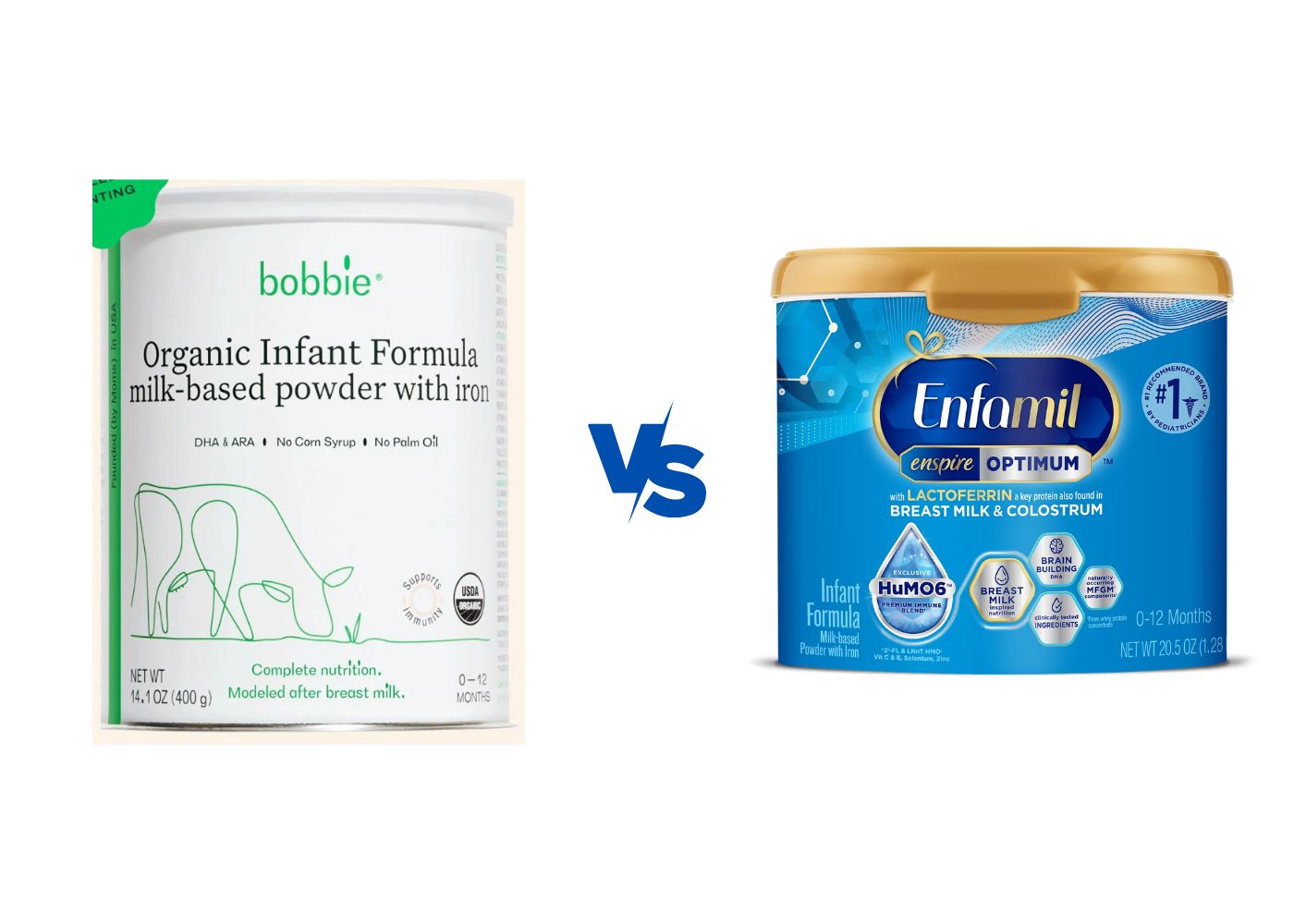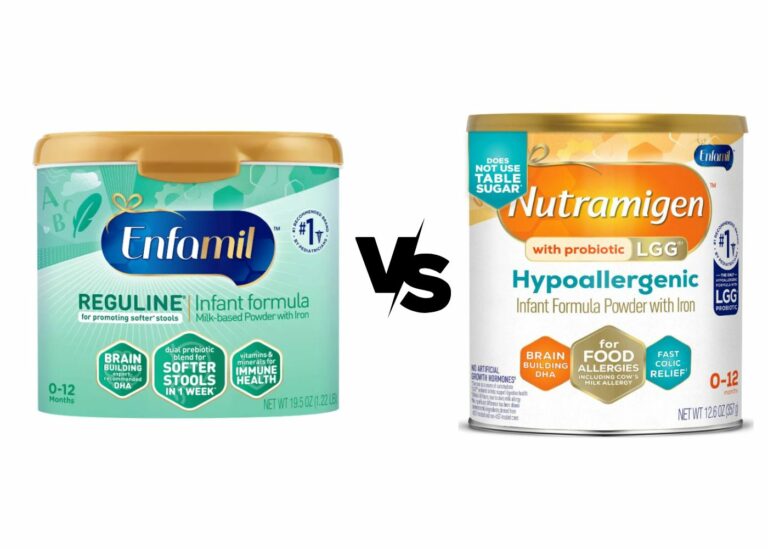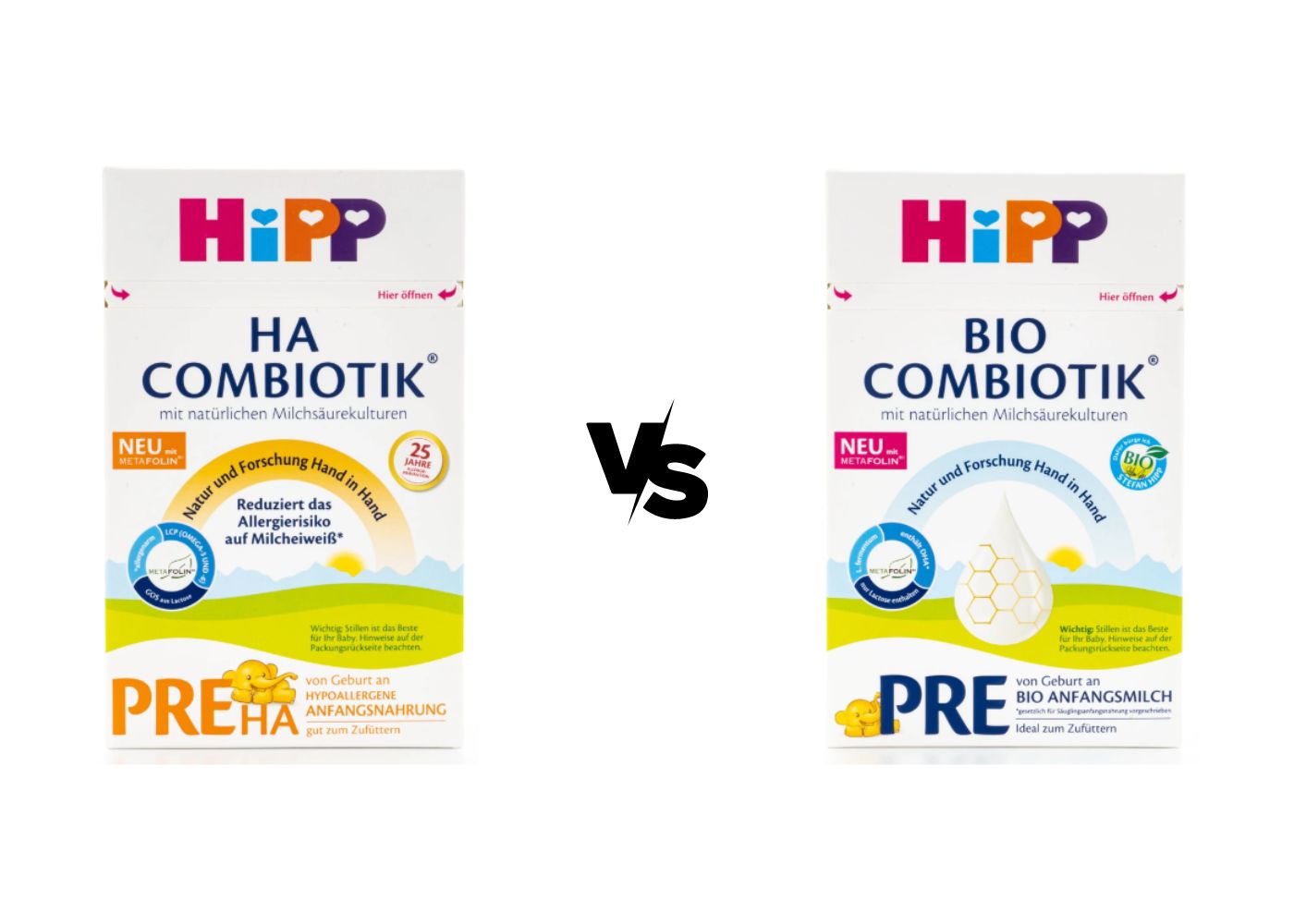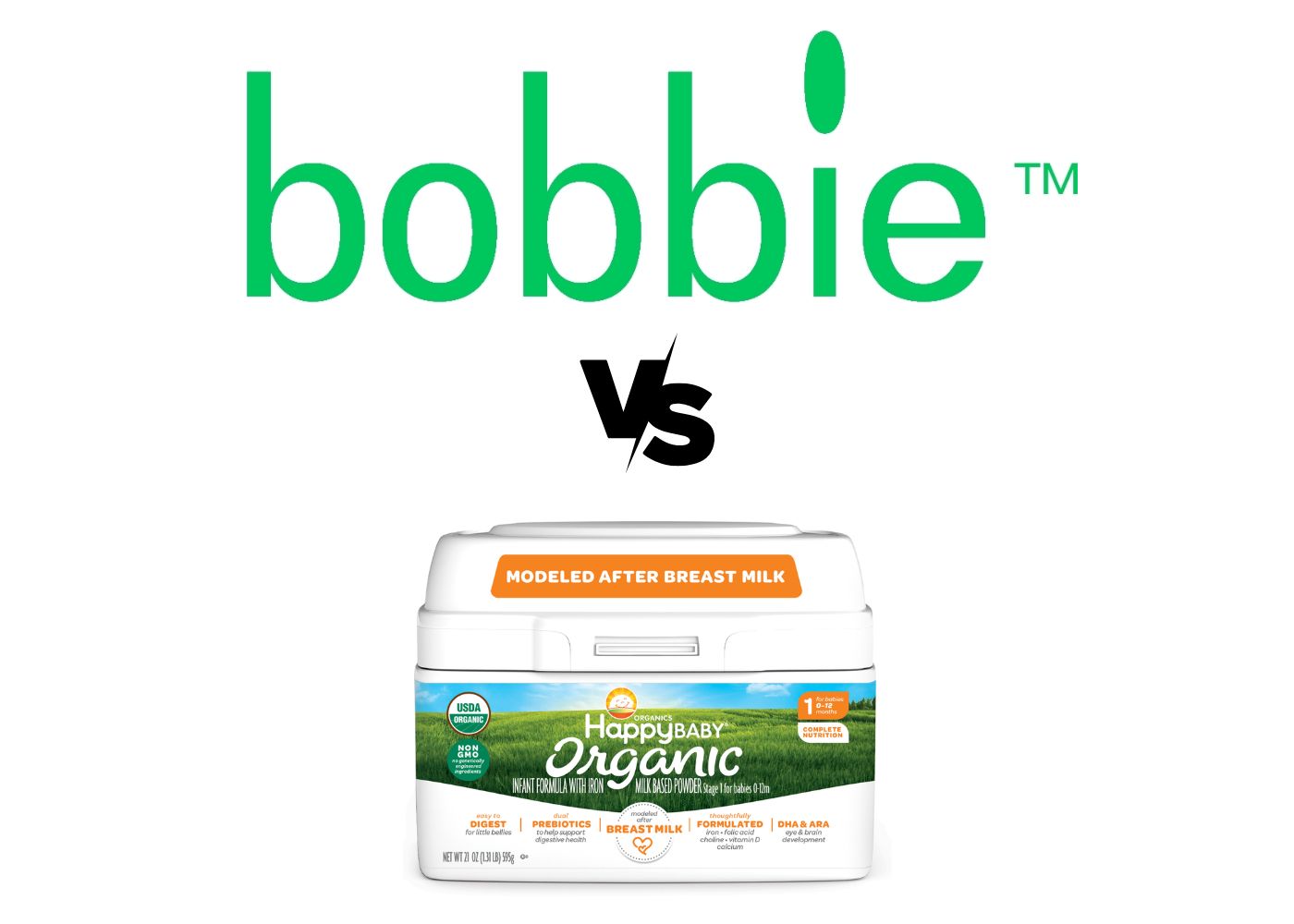
Key Differences Between Bobbie and Happy Baby Formulas
| Key Differences | Bobbie | Happy Baby |
|---|---|---|
| Origin | United States | United States |
| Organic | ✅ Yes | ✅ Yes |
| Milk Source | Organic skimmed milk | Organic skimmed milk |
| Protein Content | 1.33g per 100ml, 60:40 whey-to-casein ratio | 1.38g per 100ml, 70:30 whey-to-casein ratio |
| Carbohydrate Content | Lactose only, 7.33g per 100ml | Lactose only, 8g per 100ml |
| Fats and Oils | Coconut, sunflower, and safflower oils, no palm oil | Palm olein or palm oil, soy oil, coconut oil, high oleic (safflower or sunflower) oil |
| Omega Fatty Acids | DHA | DHA |
| Prebiotics and Probiotics | None | GOS and FOS (prebiotics), no probiotics |
| Cost per OZ | $1.66 | $1.43 |
| Availability | US, may be difficult in other countries | US, may be difficult in other countries |
Blwstore is supported by its audience. When you buy through links on our site, we may earn an affiliate commission.
As a parent, you are often faced with an overwhelming number of decisions to make for your little one, especially when it comes to nutrition.
One of the most crucial choices you’ll encounter is selecting the right baby formula.
In this article: Bobbie vs Happy Baby, we will dive deep into the reputation, ingredients, and benefits of these two popular baby formulas to help you decide on your baby’s well-being.
Let’s get after it!
Our Short Answer
A close comparison, but easy to decide.
We recommend Bobbie over Happy Baby Organic due to its simpler formula, lack of palm oil or palm olein, and minimal additives.
Happy Baby is a viable option for those needing prebiotics, but if that’s your case, we recommend reading about Kendamil formula. You can check our review here.
At BLWStore, we may earn a commission from some of the products featured on our website through affiliate partnerships with retailers. We want to be transparent with our readers and let you know that we do not receive any products for special consideration. The commission we earn helps support our website and allows us to continue providing helpful information and product recommendations. Thank you for your support!
Brand Reputation
Bobbie focuses on high-quality, safe, and organic formula, closely resembling breast milk with lactose as the primary sugar source and a 60:40 whey-to-casein protein ratio.
Happy Baby offers non-GMO, organic formulas, prioritizing transparency and affordability while providing key nutrients and dual prebiotics.
Bobbie’s Philosophy
Bobbie is a US-based infant formula brand that prides itself on providing parents a high-quality, safe, and organic option.
Inspired by European ingredient sourcing practices and nutritional requirements, Bobbie meets all FDA requirements and is committed to transparency and excellence.
Bobbie’s philosophy revolves around offering a formula closest to breast milk, using only the finest ingredients, such as lactose as the primary source of sugar and a 60:40 whey-to-casein protein ratio.
They are also dedicated to environmental sustainability and rigorous testing to ensure their products are free from harmful contaminants and toxins.
Happy Baby’s Philosophy
Happy Baby is another well-known brand that offers organic infant formulas crafted to nourish babies during their crucial first year of life.
As a brand, Happy Baby prioritizes providing non-GMO, organic formulas with no corn syrup solids, and their Stage 1 formula includes key vitamins and minerals and dual prebiotics. They believe in transparency and are dedicated to providing high-quality products at an affordable price.
Happy Baby’s commitment to offering a formula closely aligned with breast milk has attracted numerous loyal customers who trust the brand’s focus on organic ingredients and nutritional value.
Nutritional Composition
Nutritional composition is by far the most important factor when choosing a formula.
Knowing the ingredients’ source and processing is essential before we choose the proper formula for our baby.
Let’s look at how Bobbie and Happy compare in this section.
Bobbie formula has a protein ratio similar to mature breast milk, uses lactose as the only carbohydrate source, and contains a blend of organic fats without palm oil.
Happy Baby formula has a slightly different protein ratio, also uses organic lactose, but includes palm olein/palm oil in its fat composition.
Bobbie’s choices align more closely with breast milk composition.
Protein Content
Just like the bricks in a building, proteins are the building blocks of our bodies.
Bobbie: Bobbie’s formula includes a 60:40 ratio of whey and casein proteins, similar to the protein ratio found in mature human breast milk. This composition supports gentle digestion and ensures the baby receives the necessary amino acids for growth and development.
Happy Baby Organic: Happy Baby Organic formula includes whey protein concentrate, with a 70:30 ratio.
What’s the whey to casein ratio of breastmilk?
| Breast Milk Stage | Whey Protein (%) | Casein Protein (%) | Whey to Casein Ratio |
|---|---|---|---|
| Colostrum | 80 – 90 | 10 – 20 | 4:1 to 9:1 |
| Transitional | 60 – 80 | 20 – 40 | 3:1 to 4:1 |
| Mature | 60 – 75 | 25 – 40 | 1.5:1 to 3:1 |
Both formulas use organic skimmed milk, but Bobbie’s formula is slightly more similar to breastmilk than Happy Baby’s.
Carbohydrate Content
Carbohydrates serve as fuel to keep your baby’s engine running.
Bobbie: The only carbohydrate source in Bobbie formula is lactose, the sugar naturally found in breast milk. This means there are no added sugars like sucrose, maltose, corn syrup, glucose syrup, brown rice syrup, or maltodextrin.
Happy Baby Organic: Similarily, Happy Baby Organic formula also uses organic lactose as its primary carbohydrate source, ensuring your baby receives natural sugars that are easily digestible and similar to breast milk.
Both formulas have the same carb source, both organic content, and only use lactose as the primary energy source.
Fats and Oils
Fats play a crucial role in your baby’s growth and brain development.
Bobbie: Bobbie formula contains a blend of high-quality organic fats such as coconut, sunflower, and safflower oils. It also includes DHA, an omega-3 fatty acid essential for brain development. Notably, Bobbie does not contain palm oil.
Happy Baby Organic: Happy Baby Organic formula uses a mix of organic fats, including palm olein or palm oil, soy oil, coconut oil, and high oleic (safflower or sunflower) oil. It also contains DHA from algal oil for brain development.
Bobbie easily wins the fat content battle because it does not contain palm olein or palm oil.
We find it strange that in the ingredient list of Happy Baby, it says “palm olein or palm oil” when they are different in nature:
| Nutritional Factor | Palm Oil | Palm Olein |
|---|---|---|
| Fat Composition | – 44% Palmitic Acid | – 39% Palmitic Acid |
| – 37% Oleic Acid | – 45% Oleic Acid | |
| – 10% Linoleic Acid | – 11% Linoleic Acid | |
| – 9% Other Fatty Acids | – 5% Other Fatty Acids | |
| Calcium Absorption | More efficient absorption | Lower absorption rate |
| Fat Absorption | Better overall absorption | Less efficient overall absorption |
| Effect on Stool Consistency | Softer stools, closer to breastfed infants | Firmer stools, may lead to constipation |
Palm Olein is basically processed palm oil, and it is not recommended. It is a cheaper alternative.
Probiotics and Prebiotics
Bobbie formula does not include prebiotics or probiotics, while Happy Baby Organic formula includes dual prebiotics (GOS and FOS) but does not contain probiotics.
Although prebiotics and probiotics are not essential ingredients in baby formulas, they can offer some benefits to your baby’s digestive health.
Prebiotics are more commonly found in formulas, while probiotics are less frequent.
We recommend choosing a formula with probiotics only if your pediatrician advises you to do so.
Bobbie: Bobbie formula does not include prebiotics or probiotics.
Happy Baby Organic: Happy Baby Organic formula features dual prebiotics, including organic galactooligosaccharides (GOS) and fructooligosaccharide (FOS), which help promote a healthy gut environment for your baby. However, it does not contain probiotics.
Cost and availability
Both Bobbie and Happy Baby Organic formulas are readily available in the United States, but they may be more difficult to find in other countries.
Bobbie tends to be more expensive due to its organic certification, manufacturing practices, and the purity of its ingredients.
Bobbie: 1.66$ per OZ
Happy Baby Organic: 1.43$ per OZ
Best Places to Buy Bobbie and Happy Baby
Less is more. That is the saying of Bobbie.
Crafted with care, focussed on essential, high-quality ingredients.
Bobbie is your go-to if you want a US-based product with an Organic European Formula quality.
- Organic American Grass-Fed Milk: Sourced from Organic Valley cows
- Iron meets FDA and EU standards
- Perfect Whey:Casein Ratio
- Organic Expeller-Pressed Fat Blend
- Organic Lactose
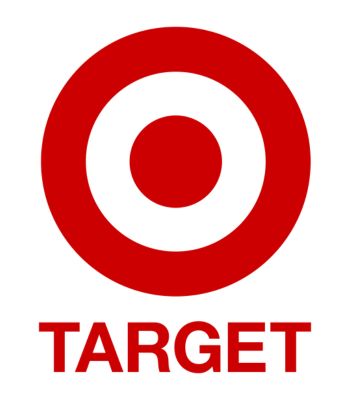

What are the best alternatives to Bobbie and Happy Baby?
If you’re considering alternatives to Bobbie and Happy Baby Organic formulas, here are three noteworthy options:
Holle: Holle stands out for its Demeter certification, which ensures the highest organic and biodynamic farming practices standards. *Read: Holle vs Bobbie
Hipp: Hipp is well-regarded for its specialty formulas, designed for easy digestion and hypoallergenic needs. *Read: Hipp or Bobbie?
Kendamil: Kendamil is known for its purity and use of whole milk, providing a high-quality formula option for parents. *Read: Kendamil or Bobbie? and Kendamil vs Happy Baby
For other Bobbie comparisons, check out: Bobbie vs Baby’s Only | Bobbie vs Kirkland
Conclusion
In this comparison, we find it easy to choose Bobbie over Happy Baby Organic.
While both formulas share similarities, Bobbie excels because it does not use palm oil or palm olein and offers a simpler, more straightforward formula with the least amount of additives possible.
Happy Baby remains a great option if you need a formula with prebiotics, but in that case, we’d recommend considering Kendamil. You can check our Kendamil Review if you’re interested in learning more.
We’re Maria and Alberto, a married couple and educators who are nutrition enthusiasts. Even before we had kids, we were already crazy about nutrition.
We’d read scientific articles, watch videos from nutritionists, and spend hours listening to nutrition podcasts.
Today, we continue doing this, but in a different way, as we’ve learned to sift through the noise and trends. Nutrition, like any other field of knowledge, the more you read and learn, the more you develop a comprehensive understanding of reality, and that’s what has happened to us.
Before having our first child, we focused on learning everything we could about child nutrition, using the same techniques we had already employed, backed by our extensive knowledge in nutrition.
Our mission is to help other parents with their children’s nutrition, to help them become the best versions of themselves.
If we are what we eat and drink, which is absolutely true, let’s do it right!


